- ▶
- Heaters/Source
- ▶
- Agilent Heaters and SensorsMass Spectrometry, Scientific Supplies & ManufacturingScientific Instrument Services 5973 Source Heater Tamper Resistant Allen Wrench 5973/5975 Quad Sensor 5985 Source Heater Assembly Agilent Interface Heater Assembly 5971 Interface Heater

- ▶
- LiteratureApplication Notes Adsorbent Resins Guide Mass Spec Tips SDS Sheets FAQ MS Calibration Compound Spectra Manuals MS Links/Labs/ Organizations MS Online Tools Flyers on Products/Services Scientific Supplies Catalog About Us NextAdvance Bullet Blender® Homogenizer Protocols Micro-Mesh® Literature Instrumentation Literature Agilent GC/MS Literature SIS News / E-Mail Newsletter NIST MS Database - Update Notifications

- ▶
- Application NotesNote 103: EPA Method 325B, Novel Thermal Desorption Instrument Modification to Improve Sensitivity Note 102: Identification of Contaminants in Powdered Beverages by Direct Extraction Thermal Desorption GC/MS Note 101: Identification of Contaminants in Powdered Foods by Direct Extraction Thermal Desorption GC/MS Note 100: Volatile and Semi-Volatile Profile Comparison of Whole Versus Cracked Versus Dry Homogenized Barley Grains by Direct Thermal Extraction Note 99: Volatile and Semi-Volatile Profile Comparison of Whole vs. Dry Homogenized Wheat, Rye and Barley Grains by Direct Thermal Extraction GC/MS Note 98: Flavor and Aroma Profiles of Truffle Oils by Thermal Desorption GC/MS Note 97: Flavor Profiles of Imported and Domestic Beers by Purge & Trap Thermal Desorption GC/MS Note 96: Reducing Warping in Mass Spectrometer Filaments, with SISAlloy® Yttria/Rhenium Filaments Note 95: Detection of Explosives on Clothing Material by Direct and AirSampling Thermal Desorption GC/MS Note 94: Detection of Nepetalactone in the Nepeta Cataria Plant by Thermal Desorption GC/MS Note 93: Detection of Benzene in Carbonated Beverages with Purge & Trap Thermal Desorption GC/MS Note 92: Yttria Coated Mass Spectrometer Filaments Note 91: AutoProbe DEP Probe Tip Temperatures Note 90: An Automated MS Direct Probe for use in an Open Access Environment Note 89: Quantitation of Organics via a Mass Spectrometer Automated Direct Probe Note 88: Analysis of Silicone Contaminants on Electronic Components by Thermal Desorption GC-MS Note 87: Design and Development of an Automated Direct Probe for a Mass Spectrometer Note 86: Simulation of a Unique Cylindrical Quadrupole Mass Analyzer Using SIMION 7.0. Note 85: Replacing an Electron Multiplier in the Agilent (HP) 5973 MSD Note 84: Vacuum Pump Exhaust Filters - Charcoal Exhaust Traps Note 83: Vacuum Pump Exhaust Filters - Oil Mist Eliminators Note 82: Vacuum Pump Exhaust Filters Note 81: Rapid Bacterial Chemotaxonomy By DirectProbe/MSD Note 80: Design, Development and Testing of a Microprocessor ControlledAutomated Short Path Thermal Desorption Apparatus Note 79: Volatile Organic Compounds From Electron Beam Cured and Partially Electron Beam Cured Packaging Using Automated Short Path Thermal Desorption Note 78: A New Solution to Eliminate MS Down-Time With No-Tool-Changing of Analytical GC Columns Note 77: The Determination of Volatile Organic Compounds in VacuumSystem Components Note 76: Determination of the Sensitivity of a CRIMS System Note 75: An Apparatus for Sampling Volatile Organics From LivePlant Material Using Short Path Thermal Desorption Note 74: Examination of Source Design in Electrospray-TOF Using SIMION 3D Note 73: The Analysis of Perfumes and their Effect on Indoor Air Pollution Note 72: 1998 Version of the NIST/EPA/NIH Mass Spectral Library, NIST98 Note 71: Flavor Profile Determination of Rice Samples Using Shor tPath Thermal Desorption GC Methods Note 70: Application of SIMION 6.0 To a Study of the Finkelstein Ion Source: Part II Note 69: Application of SIMION 6.0 To a Study of the Finkelstein Ion Source: Part 1 Note 68: Use of a PC Plug-In UV-Vis Spectrometer To Monitor the Plasma Conditions In GC-CRIMS Note 67: Using Chemical Reaction Interface Mass Spectrometry (CRIMS) To Monitor Bacterial Transport In In Situ Bioremediation Note 66: Probe Tip Design For the Optimization of Direct Insertion Probe Performance Note 65: Determination of Ethylene by Adsorbent Trapping and Thermal Desorption - Gas Chromatography Note 64: Comparison of Various GC/MS Techniques For the Analysis of Black Pepper (Piper Nigrum) Note 63: Determination of Volatile and Semi-Volatile Organics in Printer Toners Using Thermal Desorption GC Techniques Note 62: Analysis of Polymer Samples Using a Direct Insertion Probe and EI Ionization Note 61: Analysis of Sugars Via a New DEP Probe Tip For Use With theDirect Probe On the HP5973 MSD Note 60: Programmable Temperature Ramping of Samples Analyzed ViaDirect Thermal Extraction GC/MS Note 59: Computer Modeling of a TOF Reflectron With Gridless Reflector Using SIMION 3D Note 58: Direct Probe Analysis and Identification of Multicomponent Pharmaceutical Samples via Electron Impact MS Note 57: Aroma Profiles of Lavandula species Note 56: Mass Spec Maintenance & Cleaning Utilizing Micro-Mesh® Abrasive Sheets Note 55: Seasonal Variation in Flower Volatiles Note 54: Identification of Volatile Organic Compounds in Office Products Note 53: SIMION 3D v6.0 Ion Optics Simulation Software Note 52: Computer Modeling of Ion Optics in Time-of-Flight mass Spectrometry Using SIMION 3D Note 51: Development and Characterization of a New Chemical Reaction Interface for the Detection of Nonradioisotopically Labeled Analytes Using Mass Spectrometry (CRIMS) Note 50: The Analysis of Multiple Component Drug Samples Using a Direct Probe Interfaced to the HP 5973 MSD Note 49: Analysis of Cocaine Utilizing a New Direct Insertion Probe on a Hewlett Packard 5973 MSD Note 48: Demonstration of Sensitivity Levels For the Detection of Caffeine Using a New Direct Probe and Inlet for the HP 5973 MSD Note 47: The Application Of SIMION 6.0 To Problems In Time-of-Flight Mass Spectrometry Note 46: Delayed Extraction and Laser Desorption: Time-lag Focusing and Beyond Note 45: Application of SIMION 6.0 to Filament Design for Mass Spectrometer Ionization Sources Note 44: The Design Of a New Direct Probe Inlet For a Mass Spectrometer Note 43: Volatile Organic Composition In Blueberries Note 42: The Influence of Pump Oil Purity on Roughing Pumps Note 41: Hydrocarbon Production in Pine by Direct Thermal Extraction Note 40: Comparison of Septa by Direct Thermal Extraction Note 39: Comparison of Sensitivity Of Headspace GC, Purge and Trap Thermal Desorption and Direct Thermal Extraction Techniques For Volatile Organics Note 38: A New Micro Cryo-Trap For Trapping Of Volatiles At the Front Of a GC Capillary Column Note 37: Volatile Organic Emissions from Automobile Tires Note 36: Identification Of Volatile Organic Compounds In a New Automobile Note 35: Volatile Organics Composition of Cranberries Note 34: Selection Of Thermal Desorption and Cryo-Trap Parameters In the Analysis Of Teas Note 33: Changes in Volatile Organic Composition in Milk Over Time Note 32: Selection and Use of Adsorbent Resins for Purge and Trap Thermal Desorption Applications Note 31: Volatile Organic Composition in Several Cultivars of Peaches Note 30: Comparison Of Cooking Oils By Direct Thermal Extraction and Purge and Trap GC/MS Note 29: Analysis Of Volatile Organics In Oil Base Paints By Automated Headspace Sampling and GC Cryo-Focusing Note 28: Analysis Of Volatile Organics In Latex Paints By Automated Headspace Sampling and GC Cryo-Focusing Note 27: Analysis of Volatile Organics In Soils By Automated Headspace GC Note 26: Volatile Organics Present in Recycled Air Aboard a Commercial Airliner Note 25: Flavor and Aroma in Natural Bee Honey Note 24: Selection of GC Guard Columns For Use With the GC Cryo-Trap Note 23: Frangrance Qualities in Colognes Note 22: Comparison Of Volatile Compounds In Latex Paints Note 21: Detection and Identification Of Volatile and Semi-Volatile Organics In Synthetic Polymers Used In Food and Pharmaceutical Packaging Note 20: Using Direct Thermal Desorption to Assess the Potential Pool of Styrene and 4-Phenylcyclohexene In Latex-Backed Carpets Note 19: A New Programmable Cryo-Cooling/Heating Trap for the Cryo-Focusing of Volatiles and Semi-Volatiles at the Head of GC Capillary Columns Note 18: Determination of Volatile Organic Compounds In Mushrooms Note 17: Identification of Volatile Organics in Wines Over Time Note 16: Analysis of Indoor Air and Sources of Indoor Air Contamination by Thermal Desorption Note 14: Identification of Volatiles and Semi-Volatiles In Carbonated Colas Note 13: Identification and Quantification of Semi-Volatiles In Soil Using Direct Thermal Desorption Note 12: Identification of the Volatile and Semi-Volatile Organics In Chewing Gums By Direct Thermal Desorption Note 11: Flavor/Fragrance Profiles of Instant and Ground Coffees By Short Path Thermal Desorption Note 10: Quantification of Naphthalene In a Contaminated Pharmaceutical Product By Short Path Thermal Desorption Note 9: Methodologies For the Quantification Of Purge and Trap Thermal Desorption and Direct Thermal Desorption Analyses Note 8: Detection of Volatile Organic Compounds In Liquids Utilizing the Short Path Thermal Desorption System Note 7: Chemical Residue Analysis of Pharmaceuticals Using The Short Path Thermal Desorption System Note 6: Direct Thermal Analysis of Plastic Food Wraps Using the Short Path Thermal Desorption System Note 5: Direct Thermal Analysis Using the Short Path Thermal Desorption System Note 4: Direct Analysis of Spices and Coffee Note 3: Indoor Air Pollution Note 2: Detection of Arson Accelerants Using Dynamic Headspace with Tenax® Cartridges Thermal Desorption and Cryofocusing Note 1: Determination of Off-Odors and Other Volatile Organics In Food Packaging Films By Direct Thermal Analysis-GC-MS Tech No. "A" Note 14: Elimination of "Memory" Peaks in Thermal Desorption Improving Sensitivity in the H.P. 5971 MSD and Other Mass Spectrometers - Part I of II Improving Sensitivity in the H.P. 5971 MSD and Other Mass Spectrometers- Part II of II Adsorbent Resins Guide Development and Field Tests of an Automated Pyrolysis Insert for Gas Chromatography. Hydrocarbon Production in Pine by Direct Thermal Extraction A New Micro Cryo-Trap for the Trapping of Volatiles at the Front of a GC Capillary (019P) - Comparison of Septa by Direct Thermal Extraction Volatile Organic Composition in Blueberry Identification of Volatile Organic Compounds in Office Products Detection and Indentification of Volatiles in Oil Base Paintsby Headspace GC with On Column Cryo-Trapping Evaluation of Septa Using a Direct Thermal Extraction Technique INFLUENCE OF STORAGE ON BLUEBERRY VOLATILES Selection of Thermal Desorption and Cryo-Trap Parameters in the Analysis of Teas Redesign and Performance of a Diffusion Based Solvent Removal Interface for LC/MS The Design of a New Direct Probe Inlet for a Mass Spectrometer Analytes Using Mass Spectrometry (CRIMS) Application of SIMION 6.0 to Filament Design for Mass Spectrometer Ionization Sources A Student Guide for SIMION Modeling Software Application of SIMION 6.0 to Problems in Time-of-flight Mass Spectrometry Comparison of Sensitivity of Headspace GC, Purge and TrapThermal Desorption and Direct Thermal Extraction Techniques forVolatile Organics The Influence of Pump Oil Purity on Roughing Pumps Analysis of Motor Oils Using Thermal Desorption-Gas Chromatography-Mass Spectrometry IDENTIFICATION OF VOLATILE ORGANIC COMPOUNDS IN PAPER PRODUCTS Computer Modeling of Ion Optics in Time-of-Flight mass Spectrometry using SIMION 3D Seasonal Variation in Flower Volatiles Development of and Automated Microprocessor Controlled Gas chromatograph Fraction Collector / Olfactometer Delayed Extraction and Laser Desorption: Time-lag Focusing and Beyond A New Micro Cryo-Trap for the Trapping of Volatiles at the Front of a GC Column Design of a Microprocessor Controlled Short Path Thermal Desorption Autosampler Computer Modeling of Ion Optics in Time-of-Flight Mass Spectrometry Using SIMION 3D Thermal Desorption Instrumentation for Characterization of Odors and Flavors

- ▶
- Note 53: SIMION 3D v6.0 Ion Optics Simulation Software (This Page)
(This poster was presented at the New Product Section at AVS'96)
INTRODUCTION
What is SIMION?
The SIMION software is the industry standard for the modeling of electron and ion optics. The new release, SIMION 3D v6.0, represents a breakthrough in the capabilities of computer simulation. It's expanded versatility and power allow the simulation of highly complex systems, interactive parameter manipulation with immediate feedback, and multi-ion trajectory visualization (Manual Cover figure, file: avs96f0). The original SIMION was an electrostatic lens analysis and design program developed by D. C. McGilvery at Latrobe University, Bundoora Victoria, Australia, 1977. SIMION v6.0 for the PC, developed at the Idaho National Engineering Laboratory, shares little more than its name with the original McGilvery version. INEL's fifth major SIMION release, version 6.0, represents a quantum improvement over previous versions. This C based program can model complex problems using an ion optics workbench that can hold up to 20 2D and/or 3D electrostatic/magnetic potential arrays. Arrays can have up to 10,000,000 points. SIMION 3D's 32 bit virtual Graphics User Interface provides a highly interactive advanced user environment. All potential arrays are visualized as 3D objects that the user can cut away to inspect ion trajectories and potential energy surfaces. User programs have been greatly extended in versatility and power. A new geometry file option supports the definition of highly complex array geometry. Extensive algorithm modifications have dramatically improved this version's computational speed and accuracy.
New Features
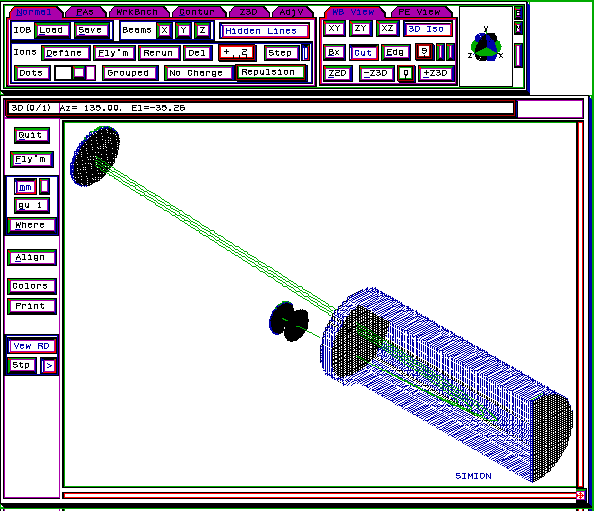
Figure 1. Simulation of a Reflectron TOFMS
The Ion Optics Bench:
The new version includes many new features. Simulation takes place on an "Ion Optics Bench" (IOB) that can hold up to 200 individual 3D electrostatic or magnetic arrays. This allows sections of an instrument to be modeled and then positioned and sized individually. Each array can have a different symmetry or point resolution. In this way, complex systems or even entire instruments can be modeled. 3D views (with 32 bit graphics) can be cut open and rotated to observe interior structures and the paths of ions trajectories within objects, Figure 1. The source, reflector and detector are each individual elements that can be positioned within the IOB. The Source and Reflector are simulated with a higher resolution than the detector. The Red and Blue lines represent the trajectories ions of with different masses. For each mass two different initial kinetic energies are simulated.
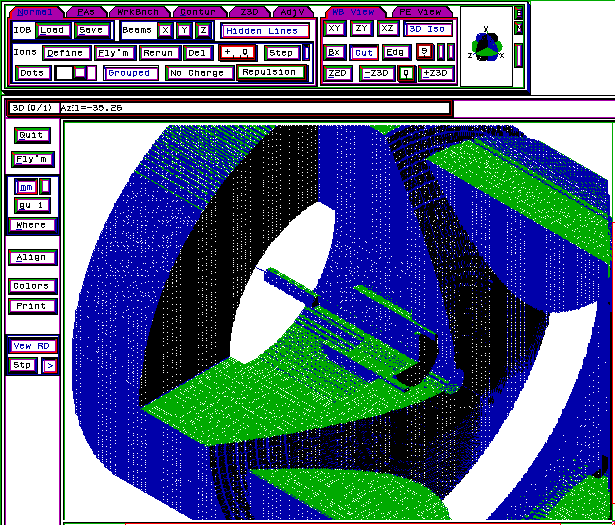
Figure 2. Cutaway of a complicated TOF-SIMS source designed by David Dahl
The reflector has been cut open in order to show the paths of ions ionside. Defining Geometrys: Each array is defined using powerful geometry files or with SIMION's Modify function. The Modify function uses a new 32 bit graphical user interface. The ability to generate complex three dimensional shapes surpasses that found in some 3D CAD programs. Features include the ability to perform logical operations on shapes (subtract a triangle from a cylinder), the definition of hyperbolas and parabolas, and the ability to define elements whose magnetic strength or electrical potential vary with position, Figure 2. This geometry was defined using a "geometry file" that contained as series of instructions (similar in structure to C language functions) that defined the shape and properties of elements in the potential array.
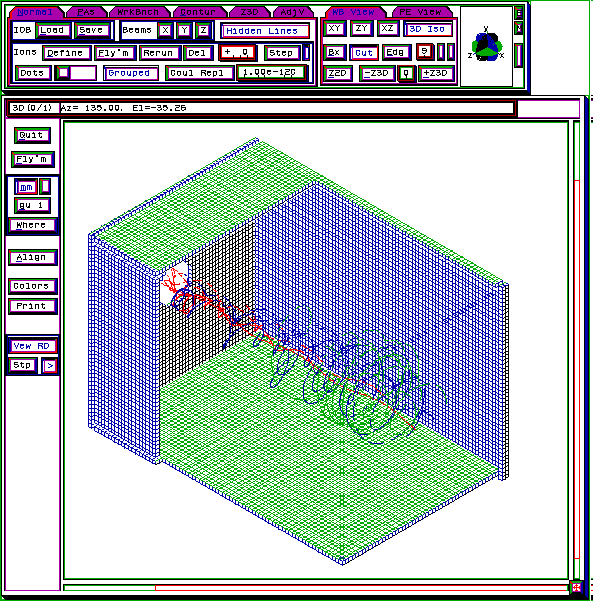
Figure 3. Simulation of a FTMS Ion Trap
Time Dependent Fields:
Array potentials can now be changed so rapidly that it is possible to simulate time dependent electrodes, as those found in an ion trap or quadrupole mass spectrometer. Fluctuating potential energy surfaces can even be observed. It is highly illustrative to observe ions "rolling down the hill" during simulations. Rapid changes in electrode potentials allow for the quick optimization of instrument conditions. For example, the user can change the voltage on a lens element and immediately see how ion trajectories are affected. In Figure, 3 the circular motion of ions in an FTS ion trap is shown. At each phase of the simulation (ion introduction, stimulation, and detection), ions are made to change color so that the effects can be clearly observed. This example is particularly useful for demonstrating the effects of space charge.
Ion Simulation:
Ions can be flown singly or in groups, displayed as lines or flying dots, and automatically be re-flown to provide movie effects when needed. New data recording features allow the user to select the parameters to be recorded and to set a variety of conditions to trigger the recording function.
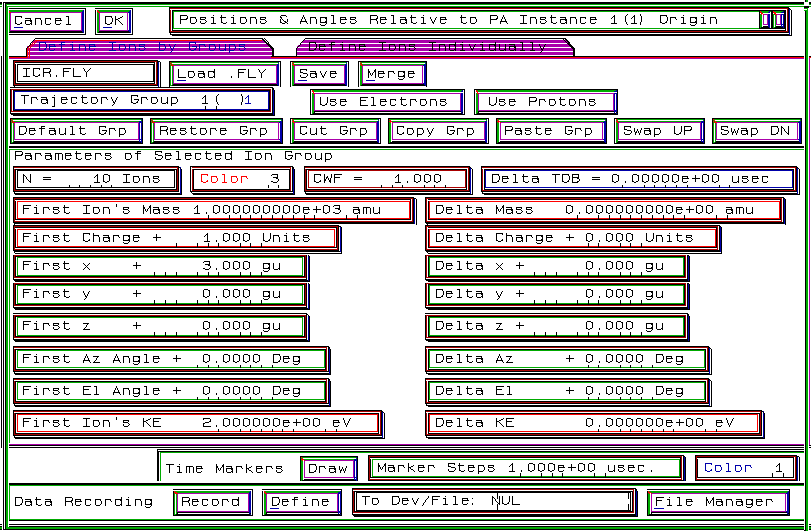
Figure 4. Screen Capture of the Ion Definition Menu
These conditions include time, position, and the crossing of boundaries. A new Data Recording menu allows the user to specify specific parameters to record and the format in which the information is saved. The Ion Deflection Menu shown in Figure 4 is a good example of the large range options available to the user in many parts of the program. In this case, we are shown the definition of the 4th of 10 groups of ions. This group has 20 members who differ by their initial kinetic energy. The record button on the lower left opens an equally diverse set of options.
Space Charge:
Charge repulsion can be simulated in three different ways. Coulombic repulsion can be simulated by either dividing the total charge among the ions defined or by indicating that each simulated ion should represent a specific number of actual ions. The repulsion of a beam of ions can be simulated by defining a "beam current" from which ions will be repelled, Figure 5. The view is of the potential energy (z-axis) along a cross-section (z & y-axis) of a 3D geometry. The simulation includes the effects of space charge repulsion and also of collisional dampening. The dampening has the effect of slowing the ions down. As a result, they tend to follow the electrostatic field lines and collide with one of the electrodes.
Figure 5. Simulation of Ions Passing Through a Simple Lens System
User Programs
A new user program interface and debugger simplifies the process of defining user programs. These programs may be used to control time dependent potentials. They can also be employed to simulate a variety of effects including the random generation or metastable fragmentation of ions. User programs can also be used to optimize conditions in an instrument. This is done through the recording of ion trajectories and the feedback of the results into an optimization routine. More advanced problems, like a Monte Carlo simulation of the scattering of ions at grids (2,3), are only possible with the new user programming features now available, Figure 6 shows the use of. random numbers to determine the starting conditions and "ionization" position in the simulation of a quadrupole. In this example, electrons (black) are generated at a filament (green) with a variety of initial conditions. Each group of electrons is then "converted" into ions (red) at a random time. For conversion, a user program gives the electrons a new charge and mass corresponding to a positive ion. The ions are given a random energy and direction from the appropriate distributions. By flying many groups of ions it was possible to map out the volume in which detected ions could be generated and study the efficiency of the ionization process.
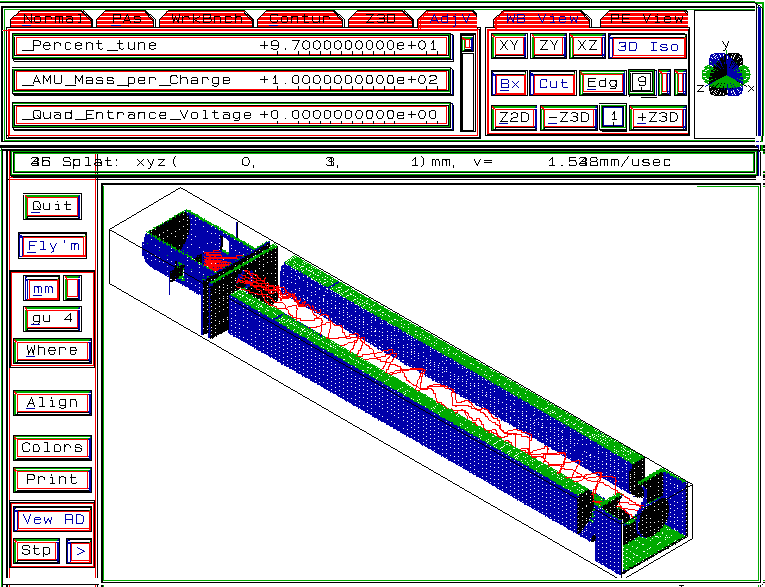
Figure 6. Monte Carlo Simulation of Electron Impact Ionization In the Source of a Quadrupole Mass Spectrometer
Teaching Ion Optics Using SIMION:
A new "Student Lab Guide", written by Kennith Busch will be released this Fall. This Guide will include hands-on exercises directed toward the teaching of ion optics with SIMION 3D. Examples will be of interest to both chemists and physicists. These tools will be designed to teach both the basic principles of ion optics engineering as well as the function of specific instruments such as mass spectrometers and ion traps.
Conclusion
SIMION 3D 6.0 is intended to provide direct and highly interactive methods for simulating a wide variety of general ion optics problems. The program balances ease-of-use, speed, and accuracy to enable it to support many real-world applications. The result is a program that can model a wide range of problems including: Ion source and detector optics, time-of-flight instruments, and ion traps. For example, it has successfully simulated the Phi-Evans TOF instrument using voltages that are within a few percent of the as-built instrument. Even if you just use it as a scoping tool (saving the hard-to-use heavy artillery for later), it can provide useful insights into your problems and perhaps help speed you toward to your final goal. This version of SIMION requires at a minimum: A 386 class PC with numerical coprocessor (or above - e.g. Pentium or P6 recommended), 8 megabytes of RAM (16 or more recommended for large projects), and at least 50 megabytes of free hard disk drive (or more). The program makes use of a 32 bit DOS virtual memory GUI (Graphics User Interface - developed by the author) that runs in, DOS, Windows (3.xx, 95, NT - Intel machines) and OS/2 (inc. Warp). The GUI video drivers support: VGA and SVGA (VESA BIOS - up to 1280x1024). GUI printer/plotter drivers support: PostScript (B/W and color), PCL5 (B/W and color), HPGL2, and HPGL.
Classes: Scientific Instrument Services, Inc. will be presenting to classes on the use of SIMON 3D software at PittCon97. For information on these or other courses that may be given in the future please contact SIS.
Additional details on SIMION 3D are available on our WEB site at http://www.sisweb.com/simion.htm
References
1. David A. Dahl 43ed ASMS Conference on Mass Spectrometry and Allied Topics, May 21-26 1995, Atlanta, Georgia, 717.
2. S. M. Colby; C. W. Baker; J. J. Manura Proc, 41st ASMS Conf. 1996. (Available at www.sisweb.com application note #47)
3. X. Tang, R. Beavis, W. Ens, F. Lafortune, B. Schueler and K. G. Standing, Int. J. Mass Spectrom. Ion Processes, 85 (1988) 43.
4. D. Ioanoviciu, Int. J. Mass Spectrom. Ion Processes, 131 (1994) 43.
5. T. Bergmann, T. P. Martin and H. Schaber, Rev. Sci. Instrum., 60 (1989) 347.
6. R. C. King, R. Goldschmidt and K. G. Owens 39th ASMS Conference on Mass Spectrometry and Allied Topics, May 19-24 1994, Nashville, TN, 717.
7. V.V. Laiko and A.F. Dodonov, Rapid Comm. Mass Spectrom. 8 (1994) 720-726

